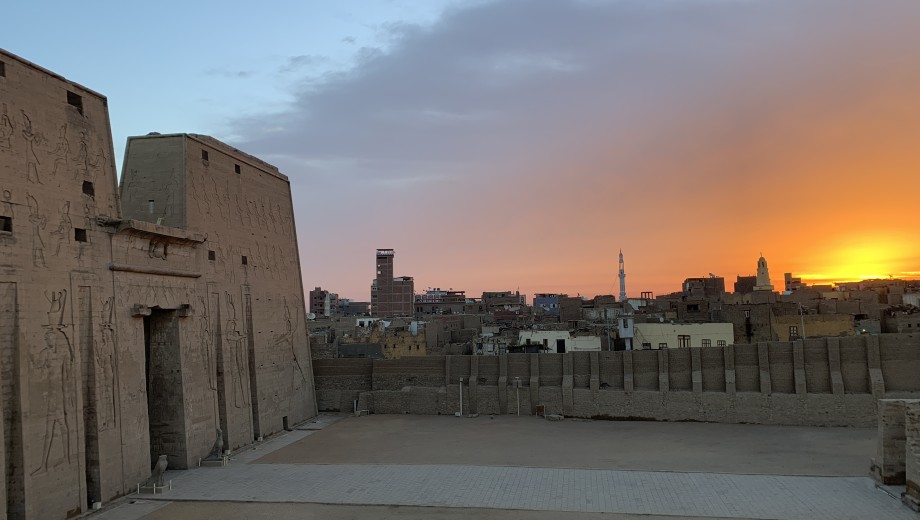The workday starts between 6:30 and 7 a.m. for professors, students, researchers, and local workers at the Tell Edfu excavation on the west bank of the Nile in southern Egypt. Over more than three millennia, settlers have been drawn to this site—near the river but elevated enough to escape annual floodwaters. Each settlement builds on the previous one, ultimately leaving a hill, or “tell.” Archaeologists have unearthed artifacts from Egypt’s Old Kingdom (around 2400 BCE) through the Ptolemaic period (332–30 BCE).
The excavation, led by the Oriental Institute, is codirected by Nadine Moeller, associate professor of Egyptian Archaeology (OI, Near Eastern Languages and Civilizations), and OI research associate Gregory Marouard. Moeller, who laid the groundwork for the excavation in 2001 while a grad student at Cambridge, was interested in what she describes as “settlement archaeology, looking at towns and cities—urbanism in ancient Egypt.” This type of research offers a glimpse into the daily lives of ancient Egyptians, in contrast to the funerary-focused excavations of pyramids and tombs. It's also more difficult work because ancient cities aren’t as well preserved.
Settlement archaeology is “very technical,” Moeller says. “You need to learn how to differentiate the layers and identify the construction, occupation, and abandonment phases of ancient buildings, how to record them, how to dig them without destroying anything,” making Tell Edfu an invaluable teaching site. Every season, Moeller and Marouard bring UChicago graduate students to join the dig, some of whom return for several seasons. “I tell my students that this is the toughest kind of archaeology you can do in Egypt,” says Moeller. “If you can handle this, everything else will be much easier.”
The 2018 season (September–December) focused on a large urban villa dating back to the early New Kingdom (about 1500 to 1450 BCE) and revealed a domestic sanctuary with a shrine dedicated to ancestor worship—the first discovery of its kind in more than 80 years.
A typical day on this dig was different for each student. Egyptian Archaeology PhD candidate Émilie Sarrazin, AM’15, was a zone supervisor, making sure the archaeologists in her roughly one-square-kilometer sector had tasks—discussing the day’s objectives and dispatching the team to their work area. Her supervisory role included entering records into the site database, taking photos (some of which were used for 3-D modeling), documenting topographic points for detailed diagrams of the site, and recording artifacts associated with different stratigraphic layers.
Fifth-year Egyptology grad student Ziting (Rebecca) Wang served as a registrar, classifying small finds, including artifacts other than pottery as well as plant and animal remains. “They come to me from the field archaeologists after basic cleaning and preliminary identification. I dry-clean the artifacts if necessary and assign a unique object number.” After further examination, Wang entered relevant details in the object database and then bagged the objects for storage.
Since Egyptology students focus on language, Wang gets excited whenever objects with text are found, giving her the chance to read and translate on-site. “One of my favorite moments was cleaning a couple’s commemorative stela from the ancestor’s shrine and reading the inscriptions on it.”
Finding inscribed materials and being able to translate the hieroglyphs (all students in the program learn how to read them) can be exciting because it gives the ancient inhabitants of the town a voice. Time periods are often determined by ceramic styles, but sometimes archaeologists find inscriptions and can also use paleography—studying how hieroglyphs are written and the way words are constructed—to date a discovery. Sometimes they find clay sealings with the name of the king inscribed; during the 2017 Tell Edfu season, the team excavated sealings naming King Djedkare-Isesi, from a late fifth dynasty settlement, which provided a precise date for the foundation of this particular part of the town.
Sasha Rohret, AM’15, an Egyptian Archaeology PhD candidate, provided a biological perspective. An organismic and evolutionary biology major before switching to archaeology, Rohret wrote her undergraduate thesis on Old Kingdom–era human remains from the Western Cemetery at Giza. “I had taken a zooarchaeology course in college that I really enjoyed,” Rohret says, “so when Nadine informed me that Edfu had a great deal of faunal material and no one yet to analyze it, I essentially called dibs.”
Rohret’s days often entailed analyzing animal bones, trying to determine what species and body part each fragment belonged to. She also washed excavated bones or studied remains in situ. Studying animal bones can tell a lot about diet and nutrition in ancient times, she says, and “help to inform us about differences in social class hierarchy and economic structure.” One particularly exciting find was juvenile hippopotamus bones that showed evidence of burning and butchery, despite the fact that eating hippos isn’t “attested in ancient texts or imagery.”
Students gain more than technical experience from field work at Tell Edfu. Third-year Egyptian Archaeology grad student Raghda (Didi) El-Behaedi says some of her favorite moments were not necessarily related to the archaeological sphere but to the people she met. “It is incredible to witness this sense of family that is cultivated between all the participants of our highly multinational team, including the incredible Egyptian excavators and workmen. It is truly so genuine and organic.”

